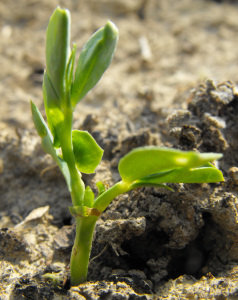
How to Make a Pea Trellis
 When the peas start poking their heads out of
the ground, it's time to hurry up and put in a trellis. Over the
past few years, we've explored a few different trellising techniques,
and I feel like we've finally settled on the best option.
When the peas start poking their heads out of
the ground, it's time to hurry up and put in a trellis. Over the
past few years, we've explored a few different trellising techniques,
and I feel like we've finally settled on the best option.
Peas need to be rotated like most other crops --- I tried to grow them
in the same spot two seasons in a row and yields went way down.
So your trellis needs to be easy to assemble and disassemble ---
permanent posts in the ground are a pain in the butt.
I bought a bunch of light, three foot metal fence posts for about $2
apiece a few years ago, and they work great for my shorter, shelling
peas. Just pound them in the ground and string up the trellis
material (more on that in a minute) and you're good to go.
 My snow peas, though, are
phenomenal. I grow Mammoth Melting Sugars, an heirloom variety
which grows six feet tall in poor soil and is more like Jack's
beanstalk in good soil. They poke over the top of the fenceposts
and drag the trellis down toward the ground. This year I'm trying
a new technique where I add long pieces of rebar to my trellis posts,
just weaving each one up through the trellis material and slipping it
into the indentation in the fence post. It looks like the rebar
will hold my trellis material upright for its full five foot height,
giving my snow peas room to run. (If you haven't bought anything
yet, a better option might be to invest in a few tall fence posts since
they come in heights up to five feet, I believe.)
My snow peas, though, are
phenomenal. I grow Mammoth Melting Sugars, an heirloom variety
which grows six feet tall in poor soil and is more like Jack's
beanstalk in good soil. They poke over the top of the fenceposts
and drag the trellis down toward the ground. This year I'm trying
a new technique where I add long pieces of rebar to my trellis posts,
just weaving each one up through the trellis material and slipping it
into the indentation in the fence post. It looks like the rebar
will hold my trellis material upright for its full five foot height,
giving my snow peas room to run. (If you haven't bought anything
yet, a better option might be to invest in a few tall fence posts since
they come in heights up to five feet, I believe.)
The only other thing you need to consider is what material to string
between the posts in your trellis. First of all, it
helps if your pea beds are similar lengths from year to year.
That
way, you can use the trellis mesh from last year with no cobbling
together smaller pieces to fill in the ends of the row.
As for type, I've tried three different plastic meshes, shown
below. My very favorite is in the middle --- it's the same sturdy
stuff Mark used on our most
recent chicken tractor, and has stood up to two years of garden use
so far with no ill effects.

Last year, I needed more trellis material to expand my pea beds and
couldn't find my favorite kind, so I bought the flimsy stuff on the
left. That type is moderately okay --- it holds up the shelling
peas, though not the snow peas. It's too light, though, so it
tends to break apart, is easy to lose in the grass, and tangles up
badly (especially in the blades of your lawn mower after you lose it in
the grass.) After one year of garden use, I've already put a dent
into its life.
I'm trying a new kind of plastic mesh, shown on the far right, this
year. This mesh is midway between the other two and looks like it
might be sturdy enough for my uses. The only downside so far is
that the cut edges are scratchy, which doesn't seem to be a problem for
the other two types. I'll keep you posted on its
longevity.
Want more in-depth information? Browse through our books.
Or explore more posts by date or by subject.
About us: Anna Hess and Mark Hamilton spent over a decade living self-sufficiently in the mountains of Virginia before moving north to start over from scratch in the foothills of Ohio. They've experimented with permaculture, no-till gardening, trailersteading, home-based microbusinesses and much more, writing about their adventures in both blogs and books.
Want to be notified when new comments are posted on this page? Click on the RSS button after you add a comment to subscribe to the comment feed, or simply check the box beside "email replies to me" while writing your comment.
